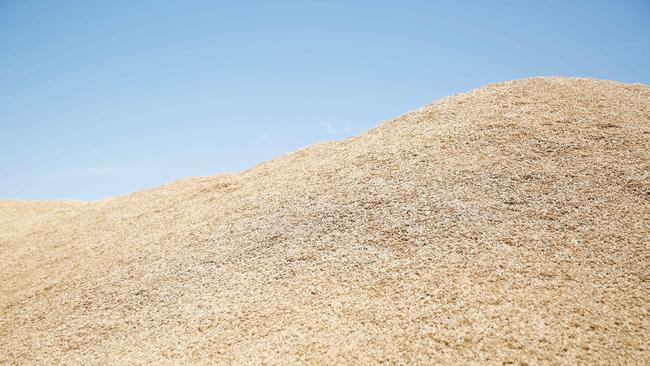Hay prices stagnate while wheat, barley lift on tight global supplies
Hay prices are not responding as they normally do, but local grain rates are holding steady against global volatility.

There are growing concerns for the production of vetch hay.
Vetch is typically sown early in the Mallee yet many crops in the western Riverina and Mallee of Victoria and South Australia are yet to germinate, as rainfall throughout the region for the past three months is less than 40 per cent of the average.
Although longer term weather forecasts are typically unreliable at this time of the year, the rainfall forecasts are for only 5mm to 10mm this week.
Given the lower-than-expected prices received for hay this season, and the higher prices for grain and canola, broadacre hay growers had already reduced their exposure to hay including vetch.
Remaining vetch supplies are mainly lower quality as buyers have snapped up the higher protein hay suited to boost some of the lower quality home-grown hay and silage that is stored on buyer’s farms.
Better quality vetch hay, testing 10 ME units of energy and 20 per cent protein, has been selling for $220 a tonne ex Mallee farm.
All of this hay received some rain while curing last spring, but some buyers have been pleased with the performance of vetch in their herds and flocks.
The spike in hay demand, caused by the flooding of pastures in the Taree region, is coming to an end.
Dairy farmers in this region have purchased vetch and some cereal hay from Victorian growers to rest their wet paddocks and avoid the mice contamination of NSW hay.
Hay growers in northern NSW have seen their haystacks decimated by mice in the past few months.
In some cases, the stacks are so riddled with mice that hay has been burnt to eliminate the mice and to dispose of the foul-smelling hay.
Hay growers of the Mallee and northern Wimmera have seen dry times in the past but have found hay to be a valuable hedge that appreciates in value to help offset lower revenues from their cropping programs. This year remains an outlier in this trend as growers are yet to receive a break and hay prices have stagnated.
Adding further weight to the domestic market is the additional carry-over of hay anticipated from the export sector.
Reduced access to shipping containers and the Chinese market have caused a hay inventory build-up that will be carried over to new-crop, reducing export demand for next season. Australian hay exporters are not alone as hay exporters in the US, Canada and Spain also have higher inventories of hay due to delays in shipping and reduced availability of containers.
TIGHT GLOBAL SUPPLIES SEND WHEAT AND BARLEY HIGHER
Volatility remains in international grain markets, but local prices are steady this week and most new-crop prices are higher.
Grain consumers had hoped that record east coast wheat and barley crops in combination with a lack of barley exports to China would mean grain prices would be lower than last year. However, the reality is a little different.
It was only six weeks ago that Australian Standard White wheat was trading at $300 a tonne delivered to Melbourne end-users.
Since then, the global challenges to grain supplies and a shortage of trucks have caused wheat prices to rally. ASW now sits $23 a tonne under last year’s values.
Grain users have been more affected by price swings of barley, the lowest cost feed grain. Two weeks ago, the price for prompt delivery barley hit the same levels as last year and barley is now trading $23 a tonne higher year on year.

The total feed costs for ruminant animals have been offset by lower hay and silage costs and higher returns, but mono-gastric livestock feeds have been affected to a greater extent.
According to the Brazilian government, the drought in the southern and central states is the worst in 91 years. The drought has seen yields of the late-planted corn crop plummet, but the grain markets have already discounted their supply numbers.
Grain price direction has switched to focus more on the northern hemisphere weather.
Improved rainfall in key regions of the EU and the US and the ideal start to the winter crop in Western Australia and NSW contribute to trader confidence for new-crop supplies.
With a week that saw limit up and limit down moves in US futures markets, wheat futures eased $4.30 a tonne in Chicago, Paris futures slipped $2.40 and Black Sea futures fell $10.70. US corn futures remain highly volatile yet are only $1.40 a tonne lower than last week. Price direction for new-crop is unchanged for cereal grains, lower for canola and higher for pulses.
Trader bids on a Geelong port basis for new-crop Australian Premium White wheat and barley are unchanged at $307 and $260 a tonne respectively.
Global oilseed markets found some support after an initial sell-off a few weeks ago, but canola for delivery this December is bid $750 a tonne, down $11.
The new-crop desi chick peas are $5 a tonne higher at $670 delivered Melbourne packers while old crop is steady at $705 a tonne. Old crop nugget lentils have slipped $55 to $845 a tonne delivered to Melbourne, but new crop is up $5 to $720 a tonne.
There is growing confidence India will import more pulses in June, but there are concerns over production challenges in Victoria, South Australia, eastern Europe and Turkey.
MORE
GRAIN GROWERS MISS OUT ON CRUCIAL AUTUMN RAIN


